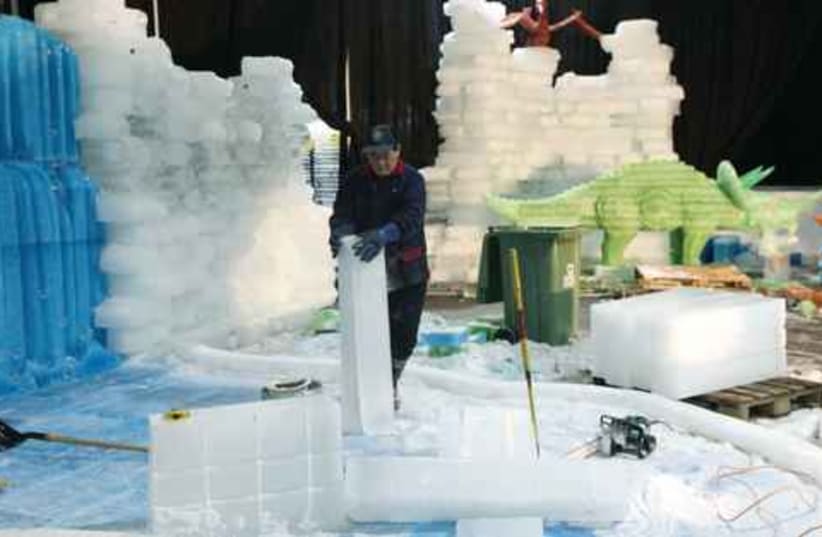The sky has been getting bluer and the flowers have begun to proliferate as spring draws closer, but over at the old Jerusalem train station compound, things are going to be staying decidedly chilly for some time longer.The frigid spot is the site of the Isracard Jerusalem Ice City, where it is not only the temperature that will take your breath away. The ice installation and skating rink made their debut last year, but this time around, the venture has taken on new dimensions.For a start, there is a mind-blowing array of frozen edifices and structures based on a Far Eastern theme, which children and adults can walk, crawl and slide through, or simply goggle at.There is, for example, a six-meter-tall, fairly passable and eminently white model of the Taj Mahal, and a suitably fierce-looking 4-m.-long shark. The Seaworld section – which for some reason looks like an igloo from the outside – sports a polychromic display of fish set into the ice blocks, and there is a towering pagoda just around the corner from the Indian palace.The statistics of the frosty creation make for jaw-dropping reading. Most of the raw materials for the icy shapes were produced with a specially tailored icemaker capable of churning out 260 blocks per day, each chunk measuring 1 m. by 50 cm. by 25 cm. and weighing in at a whopping 150 kg. The base colors of the manufactured blocks are white or transparent, with various hues added as required, according to producer Sharon Shalem-Dahan.“The colors are designed to fit in to their context inside,” she explains, referring to the obstacle course.While she rolls out the cold facts, a team of no fewer than 40 artisans from China get on with the nitty-gritty.“We almost filled up a whole plane from China,” says the producer, “and we’re bringing over 25 dancers, too.”The latter will be performing a 55- minute acrobatics and ice skating show four times a day, probably to capacity audiences of 1,500.Completing the team from the Far East is a member of a different but also important profession.“We brought over a chef to cook for the workers,” says Shalem-Dahan. “The Chinese who were here last year didn’t get into Israeli cuisine, so it was a bit tough for them. We wanted to avoid that this year.”The enterprise – a joint venture of the Jerusalem Municipality, the Ariel municipal tourism company and Isracard – opens on Wednesday and will run through April 30.But why the leap in the event’s scale? Any marketing executive would have been delighted to see as many customers as Ice City had the first time around.“We had over 300,000 members of the public at last year’s event,” states Shalem-Dahan. “We hoped we’d get that many people, but there was an avalanche over Passover. Thousands of people came then. We expect more to come this year, especially as we have added a lot to the installation.”Part of the idea behind the sophomore effort was to offer Israelis a more tangible icy experience.“The kids, and hopefully their parents, too, will slide on the ice and really feel it,” continues the producer. “There was snow in Jerusalem a few weeks ago, but ice and snow are not something we normally have here. I think, for us, there is something a bit romantic about entering into a world of ice, something a bit escapist.”BAI WEI is in charge of the construction operation, and has put up similar facilities all over the world, including in Thailand, India and the United States.Even so, there is no danger of complacency setting in.“Each exhibition and construction is different,” he says. “Each time, we build according to the specifications we are given. Each time we try to reflect the character of the place, the culture we come to.”He also works in his homeland, on the enormous structures that comprise the Harbin Ice Festival, which takes place annually in China’s northwestern region. He says he is fascinated by the reactions his creations get in different parts of the world.“In places where they have a lot of snow and cold weather, like Harbin, which is close to Siberia, the public likes what we do, but for them it is normal to see ice,” he says. “But in places like Israel, where it is much warmer, the local people express a different kind of interest. They are really curious about it.”Judging by last year’s attendance levels, the new Ice City attractions stand to bring in hordes of visitors of all ages.“There are a lot of things for kids here,” says Shalem-Dahan, “but they will bring their parents and other adults, too. I think anyone, of any age and from any walk of life, can enjoy the attractions, the show and the skating rink. It’s just pure fun.”One word of warning, though: With interior temperatures ranging between minus 10 and minus 14 degrees, you’d be best advised to take several layers of warm clothing with you.Ice City will be open Sunday-Thursday from 10 a.m. to 11 p.m., on Friday 10 a.m. to 2 p.m., and on Saturday from 7:30 p.m. or an hour after Shabbat, until 10 p.m. For tickets and more information: 623- 7000, *6226, www.jerusalem-on-ice.org.il, or www.ariel-jer.org.il.
